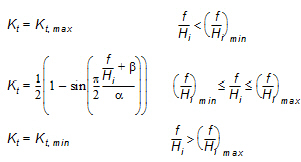
The energy balance equation for the physical process of a wave encountering a structure can be stated as
(6.23) 
where Kt is the transmission coefficient, Kr is the reflection coefficient and Kl is the loss coefficient. The transmission coefficient, Kt, describes the intensity of a transmitted wave height relative to an incident wave height. The corresponding transmission of the wave energy for each individual spectral bin is taken as Kt2. The reflection coefficient, Kr, describes the intensity of a reflected wave height relative to an incident wave height. The corresponding reflection of the wave energy for each individual spectral bin is taken as Kr2.
Using Goda's formula the transmission coefficient is given by
(6.24) 
where a and b are two fitting coefficients and Kt,min and Kt,max are the minimum and maximum transmission coefficients. Hi is the incoming wave height and f is the freeboard which is determined as the crest level minus the surface elevation. The minimum and maximum relative freeboard is given by
(6.25) 
(6.26) 
Goda's formula can be used to estimate the transmission of waves over breakwaters, dams and caisons. Both submerged and emergent or subaerial structures can be taken into account. Using Goda's formula the transmission coefficient is calculated based on the freeboard and the incoming significant wave height and the transmission coefficient is independent of the wave direction. For a vertical wall breakwater a=2.2 and b in the range 0.1 to 0.8 with a mean value of 0.4. For more detail on the values of the two fitting coefficients see Goda et. al. (1967) and Goda (1969).